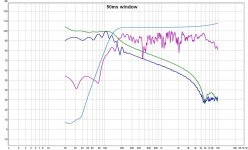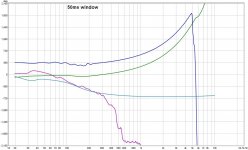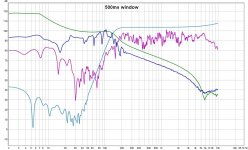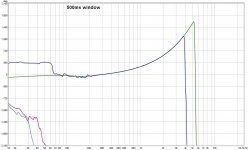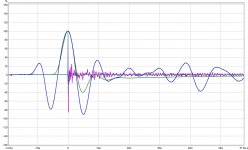Barleywater,
I wonder if some of the fact people have really liked the sound of my speakers is the simple fact that they are only two-way speakers with the crossover up at 2.5Khz? So a square wave below the crossover point should be very well produced which would seem to mean that the impulse response below the crossover would also be very good. I really haven't had to do any FR correction of the cone driver, it measures very good with no correction. So the only real issues are the crossover phase alignment and any corrections needed in the high frequency response of the tweeter. I've never seen a perfect dome tweeter and don't really expect to ever see that, not even my own device do I expect no perturbations up very high. This probably has a lot to do with the fact that I have turned to look who is talking or what the noise is when something was playing on the speakers in another room and I really was fooled into thinking it was a real event.
I wonder if some of the fact people have really liked the sound of my speakers is the simple fact that they are only two-way speakers with the crossover up at 2.5Khz? So a square wave below the crossover point should be very well produced which would seem to mean that the impulse response below the crossover would also be very good. I really haven't had to do any FR correction of the cone driver, it measures very good with no correction. So the only real issues are the crossover phase alignment and any corrections needed in the high frequency response of the tweeter. I've never seen a perfect dome tweeter and don't really expect to ever see that, not even my own device do I expect no perturbations up very high. This probably has a lot to do with the fact that I have turned to look who is talking or what the noise is when something was playing on the speakers in another room and I really was fooled into thinking it was a real event.
Barleywater,
Your right, now I have to put a whole series of things back together to do that.
Your right, now I have to put a whole series of things back together to do that.
Thanks, but all thanks go to Barleywater, who put me on the trail of this exiting possibility to do FIR filtering for no money at all.
Thank you Barleywater for putting vacuphile on the trail… 🙂
If you have a speaker near a large surface.... such as a floor, wont that coupling modify the cross-over response -- amp/slope/phase? You dont get the sim response with ideal roll-off slope/rate. Instead of 3db/oct it will be 2.5 etc.
The final adjustment of the cross-over values needs to be done with modelling that includes a surface near it.
[sorry. its just the finer details matter to me]
Forget about acoustic modeling .
Measuring the electrical output of the x-over filter is straightforward and measuring the acoustic output of the speaker drivers is troublesome.
Put measurements on the same graph. Talking about finer details.
Acoustic measurements in real environments are disorienting.
No smoothing, mic 1m from OB speaker in my living room.
50ms window and 500ms window.
We listen the way we listen. When measuring, who is to say if the 50ms window plots are closer to what we listen, from the 500ms plots or vise versa?
George
Attachments
.
Measuring the electrical output of the x-over filter is straightforward and measuring the acoustic output of the speaker drivers is troublesome.
Put measurements on the same graph. Talking about finer details.
Acoustic measurements in real environments are disorienting.
George
I am breaking it down further........ the crossover can sum perfectly in sim for a flat FR and on the bench tests.... but not in the room IF a driver is near a surface (floor, back, side-wall or all three, as in a corner). Errors show up in the cross-over region and are thus heard. When freqs are boosted by 'room gain' then the filter slopes are altered.... that nice 12db/oct slope can be 10.5dB/oct instead --- as a typical example. When this happens the response is no longer flat.
THx-RNMarsh
Last edited:
Richard,
That is fine in the case of the diy builder or someone who has the test gear to measure in room response. Most manufacturers don't have that freedom of design, you can't predict the placement in the room or even the size of the room. What do you do? I know I determined that the L/R 4 passive network had the least issues for something where you had not further control once they left your hands. Even with a dsp based network with all the bells and whistles as a manufacturer you will still have to make a choice that may be great in one room and not when somebody places the speaker in a corner or somewhere else that changes so many things..
There have been studies to find the 'typical' listening (living room) room size and its been published. Some of these size/volume studies are incorporated into Standards. EU is a little smaller than USA. You also would be aware as a system integrator (loudspeaker system) to know where the listening axis would be on a 2 or 3 way which gives the flat response and such systems need to have that axis at ear level when seated. And you know how high off the floor it is etc. After all this, you get to adjust the FR output to be flat under 'typical' listening conditions. The info for typical size/acoustic should be used in design. You will have a higher percentage of flat(er) systems in more homes that way. Most people do not listen in near field so you factor that in also.
You can also make speaker systems which are flat in near-field and a different system that is flat in far-field.
Anyway, it always sounds better in more locations of use if you do some basic listening room acoustics inclusion in the design.
So what are those factors to fold into the loudspeaker design under 'typical' listening room conditions?
THx-RNMarsh
Last edited:
Richard,
I think that typical room is a red herring, there are so many other factors that just make that almost useless. Does the room have carpet or wood floors, a bunch of upholstered furniture or not, what is one the walls, are there curtains, glass windows, door openings, it just goes on and on, how can you average all that? Room size is all over the place and so will be placement. Just try and tell the wife that the speakers have to be four feet out from the walls and away from the side walls by a certain distance and see what happens. The height on the tweeter axis you can say should be at ear height and if you sell a stand to go with a small monitor that may work but someone else may just put them on top of whatever they think looks good. There truly is no such thing as an average room to design towards.
I think that typical room is a red herring, there are so many other factors that just make that almost useless. Does the room have carpet or wood floors, a bunch of upholstered furniture or not, what is one the walls, are there curtains, glass windows, door openings, it just goes on and on, how can you average all that? Room size is all over the place and so will be placement. Just try and tell the wife that the speakers have to be four feet out from the walls and away from the side walls by a certain distance and see what happens. The height on the tweeter axis you can say should be at ear height and if you sell a stand to go with a small monitor that may work but someone else may just put them on top of whatever they think looks good. There truly is no such thing as an average room to design towards.
A system should sound 'right', and always communicate that impression, completely independent of the room environment - the analogy is a musician walking into your house with a flute, say, and wandering around and playing that instrument in every nook and cranny in your home, while you likewise move about throughout your place, in a completely independent manner. At all times, it will sound like a real person playing a real instrument, irrespective of the positional relationship of the two of you - and that's how a competent system should come across ..
Not luck, but attention to detail is needed - I fluked it the first time, realised what was going on, and ever since have worked on what's needed to optimise systems to achieve that goal. Very satisfying to get there, and what makes this audio game still worthwhile ... 😉.
Well, don't be like JC - tell us precisely what you did. And let's skip the desk top PC speakers and get straight to a real set up.
George;
Your results are disorienting and disoriented.
Phase plots of electrical response correspond to wrong point for t=0.
If FR plot shows real behavior of woofer it is passing way too much signal both below 20Hz and above 200Hz.
15ms-25ms half windows of a Blackman flavor likely will give you the most useful information. Look for window that shows deepest null at crossover with polarity reversed on one of the drivers.
Your results are disorienting and disoriented.
Phase plots of electrical response correspond to wrong point for t=0.
If FR plot shows real behavior of woofer it is passing way too much signal both below 20Hz and above 200Hz.
15ms-25ms half windows of a Blackman flavor likely will give you the most useful information. Look for window that shows deepest null at crossover with polarity reversed on one of the drivers.
Well, don't be like JC - tell us precisely what you did. And let's skip the desk top PC speakers and get straight to a real set up.

I thought they were laptops!
The point about the PC speakers, and now just using a laptop, relying on internal speakers, is understanding the common factors, the core of what needs to be optimised in every situation - there is a continuum in what can be achieved from the highest to the lowest, in nominal capabilities.
Key factors in what made the original, "real" setup work - which I have already described many times - were:
Simplicity: there was only a high end CD player, the best Yamaha you could get in the mid '80s, feeding a nominally muscular Perreaux power amp, and B&W bookshelf speakers. No source switching, or extras.
Integrity of the chain: there was no analogue volume pot - the Yamaha did proper digital volume control, all the components were hardwired together, every connection that relied on a pressure contact, metal to metal, was modified to be airtight by soldering - from the power lead in to the terminations on the speaker drivers
Stabilising of the speakers: this were set up to be as rigidly locked to the floor structure as I could, effectively the carcase vibrations were heavily damped
Long term conditioning of the electronics: this meant leaving everything on 24/7, the CD player especially was sensitive to this - from cold it took ages to develop the best quality
Strenuous conditioning of the speakers: feeding them highly energetic material so that crossovers and driver suspensions were at their best.
I didn't decide to do this from day one - each step occurred because I had a thought, experimented, or just noticed a behaviour pattern; the SQ kept improving with each iteration.
The amplifier was actually the weakest link, its smoothing caps were way not good enough, and I spent long periods trying to wring more from them as is - and much later did major surgery "fixing" this.
Note that no substituting with fancy electronic parts was done, no altering of the circuitry as delivered from the factory was done - I was simply identifying what looked to me as weaknesses, and "beefed" those areas up.
This gave me short bursts of the sound that floored me the first time I heard it - and everything since has been refining my understanding of what needs to be looked at.
Key factors in what made the original, "real" setup work - which I have already described many times - were:
Simplicity: there was only a high end CD player, the best Yamaha you could get in the mid '80s, feeding a nominally muscular Perreaux power amp, and B&W bookshelf speakers. No source switching, or extras.
Integrity of the chain: there was no analogue volume pot - the Yamaha did proper digital volume control, all the components were hardwired together, every connection that relied on a pressure contact, metal to metal, was modified to be airtight by soldering - from the power lead in to the terminations on the speaker drivers
Stabilising of the speakers: this were set up to be as rigidly locked to the floor structure as I could, effectively the carcase vibrations were heavily damped
Long term conditioning of the electronics: this meant leaving everything on 24/7, the CD player especially was sensitive to this - from cold it took ages to develop the best quality
Strenuous conditioning of the speakers: feeding them highly energetic material so that crossovers and driver suspensions were at their best.
I didn't decide to do this from day one - each step occurred because I had a thought, experimented, or just noticed a behaviour pattern; the SQ kept improving with each iteration.
The amplifier was actually the weakest link, its smoothing caps were way not good enough, and I spent long periods trying to wring more from them as is - and much later did major surgery "fixing" this.
Note that no substituting with fancy electronic parts was done, no altering of the circuitry as delivered from the factory was done - I was simply identifying what looked to me as weaknesses, and "beefed" those areas up.
This gave me short bursts of the sound that floored me the first time I heard it - and everything since has been refining my understanding of what needs to be looked at.
Last edited:
The amplifier was actually the weakest link, its smoothing caps were way not good enough, and I spent long periods trying to wring more from them as is - and much later did major surgery "fixing" this.
Chimes in with my experience - classAB amps (even opamps which aren't very lightly loaded) are a weak link because of inadequate power supplies. I notice Bonsai's addressed this concern for the opamps in his latest preamp design.
Now this is something tangible. Thank you. Although I have issues with it, I appreciate having some empirical with the subjective. And it may help that I have eaten, and listening to the second PDQ Bach LP on Vanguard, VSD-79223, the oratorio The Seasonings.The point about the PC speakers, and now just using a laptop, relying on internal speakers, is understanding the common factors, the core of what needs to be optimised in every situation - there is a continuum in what can be achieved from the highest to the lowest, in nominal capabilities.
Key factors in what made the original, "real" setup work - which I have already described many times - were:
Simplicity: there was only a high end CD player, the best Yamaha you could get in the mid '80s, feeding a nominally muscular Perreaux power amp, and B&W bookshelf speakers. No source switching, or extras.
Integrity of the chain: there was no analogue volume pot - the Yamaha did proper digital volume control, all the components were hardwired together, every connection that relied on a pressure contact, metal to metal, was modified to be airtight by soldering - from the power lead in to the terminations on the speaker drivers
Stabilising of the speakers: this were set up to be as rigidly locked to the floor structure as I could, effectively the carcase vibrations were heavily damped
Long term conditioning of the electronics: this meant leaving everything on 24/7, the CD player especially was sensitive to this - from cold it took ages to develop the best quality
Strenuous conditioning of the speakers: feeding them highly energetic material so that crossovers and driver suspensions were at their best.
I didn't decide to do this from day one - each step occurred because I had a thought, experimented, or just noticed a behaviour pattern; the SQ kept improving with each iteration.
The amplifier was actually the weakest link, its smoothing caps were way not good enough, and I spent long periods trying to wring more from them as is - and much later did major surgery "fixing" this.
Note that no substituting with fancy electronic parts was done, no altering of the circuitry as delivered from the factory was done - I was simply identifying what looked to me as weaknesses, and "beefed" those areas up.
This gave me short bursts of the sound that floored me the first time I heard it - and everything since has been refining my understanding of what needs to be looked at.
You're welcome. This has all been said by me before, in various posts - there's nothing new been added. Note that this setup always had issues, in that the SQ I was after would degrade fairly quickly from a peak, it took many years to get a better handle on some things. As echoed by Richard, my amplifier was the number one culprit for many deficiencies, it was only years later that I started using simulators, and understood a lot more about the 'real' workings of this part of the system.
Richard,
I think that typical room is a red herring, there are so many other factors that just make that almost useless. Does the room have carpet or wood floors, a bunch of upholstered furniture or not, what is one the walls, are there curtains, glass windows, door openings, it just goes on and on, how can you average all that? Room size is all over the place and so will be placement. Just try and tell the wife that the speakers have to be four feet out from the walls and away from the side walls by a certain distance and see what happens. The height on the tweeter axis you can say should be at ear height and if you sell a stand to go with a small monitor that may work but someone else may just put them on top of whatever they think looks good. There truly is no such thing as an average room to design towards.
yes there is. Average is average and exceptions are exceptions. All these things are already studied and found and used. And, they are not hard to measure nor find out about. Just as there is an average size home in square footage. If you dont want to learn about this then you can just go to a more narrow dispersion and not be bothered. A wide dispersion puts every listener at the mercy of the room to a much larger degree.
THx-RNMarsh
Question: Who produced the first consumer RTA design and published it?
name, publication, date.
THx-RNMarsh
name, publication, date.
THx-RNMarsh
Richard,
It is just a statistical number with no real value. Average room size will be different in California than in NY, different again in some Northern states. My living room is about 15' x 30' foot with sloping ceiling and a brick fireplace 16' high and 20' foot wide, there is no real average room. Then you have to look at the direction people will place the speakers, down the long distance or across the narrow distance. My last house had 20' flat ceiling and a staircase to the second floor but smaller in length. It is useless information in my opinion.
It is just a statistical number with no real value. Average room size will be different in California than in NY, different again in some Northern states. My living room is about 15' x 30' foot with sloping ceiling and a brick fireplace 16' high and 20' foot wide, there is no real average room. Then you have to look at the direction people will place the speakers, down the long distance or across the narrow distance. My last house had 20' flat ceiling and a staircase to the second floor but smaller in length. It is useless information in my opinion.
- Status
- Not open for further replies.
- Home
- Member Areas
- The Lounge
- John Curl's Blowtorch preamplifier part II
